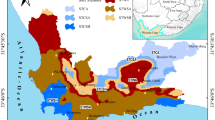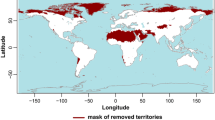Abstract
Drought is one of the most frequent and widespread natural hazards in Tien Giang province of Vietnam, which is aggravating under the influence of climate change. As agriculture is the primary economy of the province, it is crucial to understand the influence of climate change on drought severity and how the local farmers perceive and adapt to climate change. Therefore, to examine the impacts of climate change on drought in the Tien Giang province in the Mekong Delta, the present study used three General Circulation Models (GCMs)—ACCESS 1.3, CNRM-CM5, and MRI-CGCM3 under two Representative Concentration Pathways (RCP) 4.5 and 8.5 scenarios. In addition, the study evaluated household-level adaptation strategies based on structured questionnaire-based household survey data and focus group discussion. This study finds that the drought will be getting more severe in the future in the province based on using three GCMs and two climate change scenarios. The estimated results of the Standardized Precipitation Index (SPI) show that there would be many potential extreme drought years between 2020 and 2050. The results from the questionnaire survey depicted that the household perception of drought is moderate in the Mekong Delta. The current adaptation measures are sufficient to adapt to moderate drought and can be improved to adapt to more potential extreme drought conditions in the future. This study provides important insights for decision-makers to manage future drought situations in the Mekong region.







Similar content being viewed by others
Data Availability
The datasets generated during and/or analyzed during the current study are available from the corresponding author upon reasonable request.
References
Ahmed K, Shahid S, Chung E-S, Ismail T, Wang X-J (2017) Spatial distribution of secular trends in annual and seasonal precipitation over Pakistan. Climate Res 74(2):95–107
Bateni MM, Behmanesh J, De Michele C, Bazrafshan J, Rezaie H (2018) Composite agrometeorological drought index accounting for seasonality and autocorrelation. J Hydrol Engineering, 23(6). https://doi.org/10.1061/(ASCE)HE.1943-5584.0001654
Betrie GD, Mohamed YA, van Griensven A, Srinivasan R (2011) Sediment management modelling in the Blue Nile Basin using SWAT model. Hydrol Earth Syst Sci 15(3):807–818
Boonwichai S, Shrestha S, Babel MS, Weesakul S, Datta A (2018) Climate change impacts on irrigation water requirement, crop water productivity and rice yield in the Songkhram River Basin, Thailand. J Clean Prod 198:1157–1164
Byrareddy V, Kouadio L, Mushtaq S, Kath J, Stone R (2021) Coping with drought: lessons learned from robusta coffee growers in Vietnam. Climate Serv 22:100229
Chen J, Brissette FP, Chaumont D, Braun M (2013) Finding appropriate bias correction methods in downscaling precipitation for hydrologic impact studies over North America. Water Resour Res 49(7):4187–4205
Cunha APM, Zeri M, Deusdará Leal K, Costa L, Cuartas LA, Marengo JA, Tomasella J, Vieira RM, Barbosa AA, Cunningham C, Cal Garcia JV, Broedel E, Alvalá R, Ribeiro-Neto G (2019) Extreme drought events over Brazil from 2011 to 2019. Atmosphere. https://doi.org/10.3390/atmos10110642
GFDRR (2017) Toward integrated disaster risk management in Vietnam. In World Bank. https://doi.org/10.1596/28871
Giao NT, Van Cong N, Nhien HTH (2021) Using remote sensing and multivariate statistics in analyzing the relationship between land use pattern and water quality in Tien Giang Province, Vietnam. Water (switzerland) 13(8):1–16. https://doi.org/10.3390/w13081093
GSO (2019) Statistical yearbook of Vietnam. Statistical publishing house Hanoi, Vietnam
Ho TDN, Kuwornu JKM, Tsusaka TW (2022) Factors influencing smallholder rice farmers’ vulnerability to climate change and variability in the Mekong Delta Region of Vietnam. Eur J Dev Res 34(1):272–302
Jaroenongard C, Babel MS, Shrestha S, Weesakul S, Nitivattananon V, Khadka D (2021) Projecting relative sea level rise under climate change at the Phrachula Chomklao Fort tide gauge in the upper Gulf of Thailand. Water 13(12):1702
Kantoush S, Van BINH D, Sumi T, Trung LV (2017) Impact of upstream hydropower dams and climate change on hydrodynamics of Vietnamese Mekong Delta. 土木学会論文集 B1 (水工学), 73(4), I_109-I_114
Keshavarz M, Maleksaeidi H, Karami E (2017) Livelihood vulnerability to drought: a case of rural Iran. Int J Disaster Risk Reduction 21:223–230
Lê Anh T (2020). Phân tích diễn biến lũ lụt và khô hạn ở Đồng bằng sông Cửu long trong 20 năm gần đây
Lee SK, Dang TA (2019) Spatio-temporal variations in meteorology drought over the Mekong River Delta of Vietnam in the recent decades. Paddy Water Environ, 17(1):35–44. https://doi.org/10.1007/s10333-018-0681-8
Lewis SC, Karoly DJ (2014) Assessment of forced responses of the Australian Community Climate and Earth System Simulator (ACCESS) 1.3 in CMIP5 historical detection and attribution experiments. Aust Meteorol Oceanogr J 64(2):87–102
Lwin KK, Pal I, Shrestha S, Warnitchai P (2020) Assessing social resilience of flood-vulnerable communities in Ayeyarwady Delta, Myanmar. Int J Disaster Risk Reduction 51:101745
McKee TB (1995) Drought monitoring with multiple time scales. Proceedings of 9th Conference on Applied Climatology, Boston
McKee TB, Doesken NJ, Kleist J (1993) The relationship of drought frequency and duration to time scales. Proceedings of the 8th Conference on Applied Climatology, 17(22), 179–183
Mishra AK, Singh VP (2010) A review of drought concepts. J Hydrol 391(1–2):202–216
Mohsenipour M, Shahid S, Chung E, Wang X (2018) Changing pattern of droughts during cropping seasons of Bangladesh. Water Resour Manage 32(5):1555–1568
Moss RH, Edmonds JA, Hibbard KA, Manning MR, Rose SK, Van Vuuren DP, Carter TR, Emori S, Kainuma M, Kram T (2010) The next generation of scenarios for climate change research and assessment. Nature 463(7282):747–756
Nghia BPQ, Pal I, Chollacoop N, Mukhopadhyay A (2022) Applying Google earth engine for flood mapping and monitoring in the downstream provinces of Mekong river. Progress in Disaster Science, 100235. https://doi.org/10.1016/j.pdisas.2022.100235
Nguyen NA (2017) Historic drought and salinity intrusion in the Mekong Delta in 2016: Lessons learned and response solutions. Vietnam J Sci Technol Eng 59(1):93–96
Nilawar AP, Waikar ML (2019) Impacts of climate change on streamflow and sediment concentration under RCP 4.5 and 8.5: A case study in Purna river basin India. Sci Total Environ 650:2685–2696
Pachauri RK, Meyer LA (2014) Climate change 2014: synthesis report. Contribution of working groups I, II and III to the fifth assessment report of the intergovernmental panel on climate change. Intergovernmental Panel on Climate Change: Geneva, Switzerland
Pal I, Bhatt M (2020) Drought risk management in South and South-East Asia. Sage Publications Pvt, Limited
Pramanik M, Paudel U, Mondal B, Chakraborti S, Deb P (2018) Predicting climate change impacts on the distribution of the threatened Garcinia indica in the Western Ghats, India. Clim Risk Manag 19:94–105
Randall DA (2000) General circulation model development: past, present, and future. Elsevier
Rivera JA, Penalba OC (2014) Trends and spatial patterns of drought affected area in Southern South America. Climate 2(4):264–278
Shiru MS, Shahid S, Alias N, Chung E-S (2018) Trend analysis of droughts during crop growing seasons of Nigeria. Sustainability 10(3):871
Shrestha M (2015) Linear Scaling bias correction (V.1.0) Microsoft Excel file. https://doi.org/10.13140/RG.2.1.3365.8967
Shrestha S, Shrestha M, Babel M (2016) Modelling the potential impacts of climate change on hydrology and water resources in the Indrawati River Basin, Nepal. Environ Earth Sci 75(4):1–13
Sunyer MA, Madsen H, Ang PH (2012) A comparison of different regional climate models and statistical downscaling methods for extreme rainfall estimation under climate change. Atmos Res 103:119–128
Svoboda M, Hayes M, Wood D (2012) Standardized precipitation index user guide. World Meteorological Organization (1090)
Thanh NP, Matsui Y (2011) Compost potential from solid waste: Toward sustainable agriculture and mitigation of global warming in the Mekong Delta, Vietnam. In Environmental change and agricultural sustainability in the Mekong Delta (pp. 335–354). Springer
Thilakarathne M, Sridhar V (2017) Characterization of future drought conditions in the Lower Mekong River Basin. Weather and Climate Extremes 17:47–58
Thuc T, Van Thang N, Huong HTL, Van Khiem M, Hien NX, Phong DH (2016) Climate change and sea level rise scenarios for Vietnam. Ministry of Natural Resources and Environment. Hanoi, Vietnam
Trenberth KE (1999) Conceptual framework for changes of extremes of the hydrological cycle with climate change. In Weather and climate extremes (pp. 327–339). Springer
Trzaska S, Schnarr E (2014) A review of downscaling methods for climate change projections. United States Agency for International Development by Tetra Tech ARD, September, 1–42
Udmale P, Ichikawa Y, Ning S, Shrestha S, Pal I (2020) A statistical approach towards defining national-scale meteorological droughts in India using crop data. Environ Res Lett 15(9):94090
Van de Giesen N, Liebe J, Jung G (2010) Adapting to climate change in the Volta Basin, West Africa. Curr Sci 98(8):1033–1037
Van Hoang C, Tran TQ, Nguyen YHT, Nguyen KD (2019) Is land ownership a key factor in the choice of livelihood in the Mekong Delta, Vietnam? Hum Ecol 47(5):681–691
Voldoire A, Sanchez-Gomez E, Salas y Mélia D, Decharme B, Cassou C, Sénési S, Valcke S, Beau I, Alias A, Chevallier M (2013) The CNRM-CM5. 1 global climate model: description and basic evaluation. Climate Dynamics 40(9):2091–2121
Wayne GP (2014) Representative concentration pathways. Skeptical Sci 24. https://denning.atmos.colostate.edu/ats760/Readings/RCP_Guide.pdf
Yukimoto S, Adachi Y, Hosaka M, Sakami T, Yoshimura H, Hirabara M, Tanaka TY, Shindo E, Tsujino H, Deushi M (2012) A new global climate model of the Meteorological Research Institute: MRI-CGCM3—Model description and basic performance. J Meteorol Soc Japan Ser II 90:23–64
Author information
Authors and Affiliations
Contributions
• Bui Phan Quoc Nghia: conceptualization, methodology, formal analysis, investigation, writing—original draft.
• Indrajit Pal: conceptualization, methodology, writing—review and editing.
• Malay Pramanik: writing—review and editing, visualization.
• Rajarshi Dasgupta: writing—review and editing.
Corresponding author
Ethics declarations
Ethical approval
This article is from a thesis of Mr. Bui Phan Quoc Nghia at the Asian Institute of Technology (AIT). All procedures were monitored by the thesis committee and followed AIT rules. For more details on ethical approval, please contact Dr. Indrajit Pal, chair of the thesis committee and the author of this manuscript.
Consent to participate
The authors agreed to participate in the research.
Consent for publication
The authors agreed to publish the research.
Conflict of interest
The authors declare no competing interests.
Additional information
Publisher's note
Springer Nature remains neutral with regard to jurisdictional claims in published maps and institutional affiliations.
Rights and permissions
Springer Nature or its licensor (e.g. a society or other partner) holds exclusive rights to this article under a publishing agreement with the author(s) or other rightsholder(s); author self-archiving of the accepted manuscript version of this article is solely governed by the terms of such publishing agreement and applicable law.
About this article
Cite this article
Nghia, B.P.Q., Pal, I., Pramanik, M. et al. The impact of climate change on drought and its adaptation strategies: findings from general circulation models and households in Tien Giang Province, Vietnam. Climatic Change 175, 18 (2022). https://doi.org/10.1007/s10584-022-03473-1
Received:
Accepted:
Published:
DOI: https://doi.org/10.1007/s10584-022-03473-1




